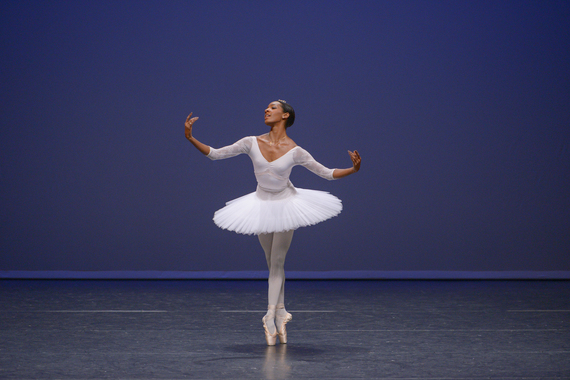At last year's Dance/USA conference, arts leaders from across the country engaged in conversations about diversity in the field of dance. As a community, we asked ourselves a simple question: How do we engage more artists, administrators, board leaders, and volunteers of color?
Backstage at Youth America Grand Prix. Photo by Phil Chan.
Classical ballet technique grew out of the court of King Louis XIV of France, and quickly assimilated into the courts of Europe and Russia. In the 20th century, ballet grafted itself onto the primarily white and upwardly mobile American elite. Dancers of color were not even given a spot on stage until the civil rights era in the United States, and to this day remain largely excluded from the major American ballet companies (an interesting article in the NY Times from 2007 profiles this history).
Despite the many benefits of engagement with the arts, we as a society have not placed a strong emphasis on arts engagement; if you divide the National Endowment for the Arts budget in 2013, what the United States government spends on the arts federally, by the general population of the country that same year, we as a nation spend $0.47 per person on a national level (this number excludes the state and local avenues for funding, which are also sadly severely limited). This means that low-income families and geographically underserved students (disproportionately students of color) who have little access to local resources receive few opportunities to explore the important benefits of the arts. This sends a very strong message: Classical ballet is not for you.
Our next step is to look at how we as a community are representing ourselves to our audiences. The question perhaps should not just be "Who are we putting on stage?" but "Who are we preparing for the stage?"
Instead of tackling the issue of race in dance head on, it may be helpful first to understand the economics of achieving a career in dance. The commitment to becoming a professional ballet dancer comes with a hefty price tag: There is the cost of shoes, tights, costumes, gas back and forth to the studio, technique classes, private coachings, summer intensive workshops -- and for the lucky few with natural talent at the right place at the right time -- a scholarship to study. Even with a scholarship, talented graduating students then travel to cities all over the world to audition for their dream companies in the hopes of getting a job. A failed audition includes the cost of the hotels, flights, and other travel expenses with no promise of a job. With costs so high, how can anyone but the most affluent children hope to even have a shot at a professional career? Under this traditional model, the most promising and talented young artists are not always the same students receiving the training to mature into the artistic leaders of tomorrow.
The young Suzanne Farrell was spotted in Cincinnati by New York City Ballet star Diana Adams, and was enrolled on a Ford Foundation scholarship at the School of American Ballet, priming her to become one of choreographer George Balanchine's greatest muses. Her story is a prime example of both the necessity and success of the scholarship model. Farrell happens to be white, but it was the access to dance education that allowed her to blossom as a ballerina. But what if the vessel of her artistic expression, the very color of her skin, were of a different shade? If access to education is key to improving involvement in dance, is improving access also the solution to the lack of diversity in the classical dance world today? What if the next Mikhail Baryshnikov or Sylvie Guillem chooses an alternative career because access to dance was not available them? I am convinced that we are not maximizing the full artistic potential of our generation.

Precious Adams, Silver Medalist from YAGP 2014 Brussels Semi-Finals. Photo by Visual Arts Masters/Siggul
I recently rejoined the staff of Youth America Grand Prix (YAGP), the world's largest global educational initiative for ballet, most recently popularized by the film "First Position." The organization sends dance luminaries all over the planet in search of talented students, offering them invitations to the New York City Finals. During the Finals, held annually every April in New York City, the directors of the top ballet schools and companies gather to adjudicate, offering the best students the chance to study on scholarship with the world's leading dance academies. The older students are offered contracts to the premier ballet companies of the world. The beauty of the model is that it is essentially the most streamlined audition process for dance with the widest geographic reach of any other model. It is the most economic way for a young student to get noticed and connected to professional resources, and the most cost effective way for directors to fill the ranks of their schools and companies with the best students from around the world in one transaction: YAGP annually engineers ballet's perfect storm.
It is because of the nature of this model that separates Youth America Grand Prix from the traditional pathway to a professional career; instead of purchasing multiple flights, booking multiple hotel rooms -- there is now only the need for one trip to New York. If a student is talented and worthy of being seen, but cannot afford the single flight and hotel, YAGP offers full financial aid through support from the Horace W. Goldsmith Foundation and the Rudin Foundation, Inc., ensuring that every talented student in America has their shot. As an organization, we are setting a goal to make even more funds available internationally to ensure that talent and potential (as opposed to financial means) now become the critical deciding factors of whether a young person has access to the resources which will help him or her develop into an artist.
And now in our 15th season, we have been able to really look back on our impact, and have come to realize that no other educational initiative has put more students of color in the ballet studio and helped them into successful professional careers than YAGP.
Looking forward to the future, we are seeing some encouraging trends: the percentage of students from underserved communities (defined in this case as communities where over half of public school children qualify for free lunch programs, or where the average household income is $50,000 or less) has grown from 21 percent in 2010 to 27 percent in 2014. This means more students from underserved communities are realizing that this is their most likely shot at a professional career. The trend continues for the New York City Finals, where the majority of the coveted scholarships and job contracts are offered: 12 percent of the New York Finalists in 2010 came from these communities, and we are projecting 16 percent of students in 2014 will make it to Finals from these communities.
This increase shows that the model is working: Personal family financial situations are becoming less of an impediment to a professional dance career. Founded by two Russian immigrants, Larissa and Gennadi Saveliev, YAGP is the ultimate reflection of the American dance dream in the 21st century. Within this model, talent and potential, not financial means, becomes the determining factor to success. Racism, overtly or subconsciously, may still be present both on stage and in the audience, but with the increase in dancers of color being connected to scholarship opportunities and jobs through the simple act of being seen, YAGP's forecast of "the future of dance" is showing that our community finally is taking not just steps, but great leaps, toward inclusivity and diversity.

